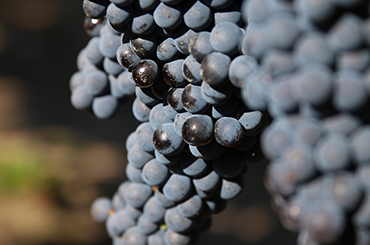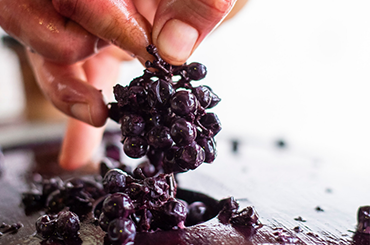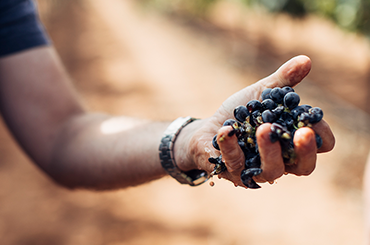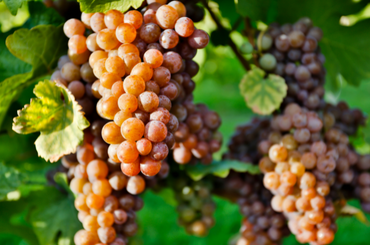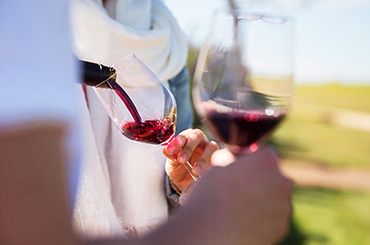Go to section: Merlot tasting characteristics | Merlot blends | Origins of merlot | How to pair food with merlot | Serving tips for merlot | The best Australian merlot regions
Merlot is a red wine grape that is known for its smooth, approachable nature. Despite being shunned in movies and on wine lists, it’s one of the most widely planted grapes in the world, largely due to its consistently high yields and tolerance to various climates and weather conditions.
Merlot displays remarkable versatility, with a range that spans from its fruity and easygoing to more mature, full-bodied and refined characters. Merlot is often blended with cabernet sauvignon – the two are such good partners they’re often mistaken for one another.
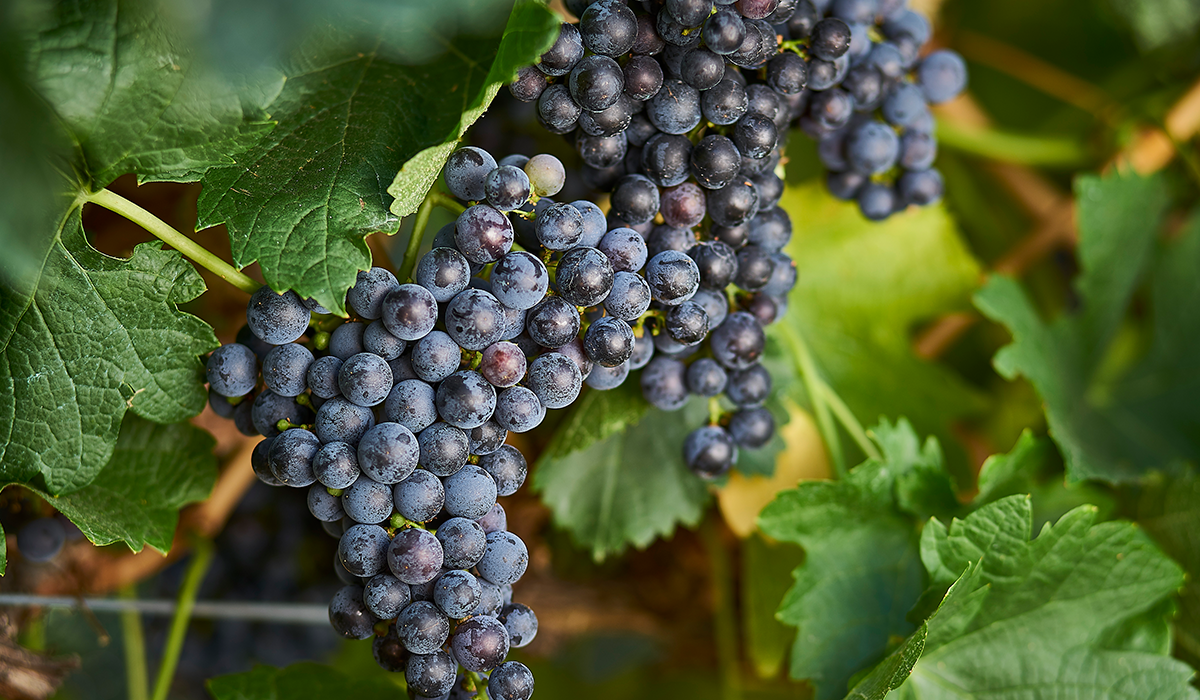
Merlot tasting characteristics
"Rich, velvety, beautifully balanced wine that will live for half a century or more if carefully cellared.” – James HallidayMerlot is a varietal that sits smack dab in the middle of the red wine spectrum. It’s most famous for its red-fruit flavours (namely cherry, plum and raspberry), easy-drinking tannins and super-soft finish. It is medium- to full-bodied, with medium alcohol (12–15 per cent), acidity, and medium-high tannins, the latter of which if often tempered by oak. Generally speaking, the warmer the growing season, the bigger (but not necessarily better) the wine.
On a good day, merlot shows a vibrant crimson hue with lifted red berry and plum fruits, oodles of spice and earthy tone and purple floral top notes.
Merlot is incredibly dark in colour, even blue at times, the trick to telling the visual difference between merlot and cabernet sauvignon all comes down to light. If you hold a glass up to the light, merlot-based wines will tinge orange around the rim.
Merlot blends
Merlot is incredibly popular in the blending world. In fact, merlot blends are the most common way for wine drinkers to enjoy the varietal. For many, many years now, Bordeaux winemakers have been blending merlot with their cabernet sauvignon and cabernet franc parcels. The reason? Merlot’s supple and smooth qualities help to balance cabernet’s structure, bringing about a softness to the wine. You can see this at work in the Château Trottvieille Saint-Émilion 2000, which is widely considered to be one of the best dry red wines in the world. That said, blending merlot is not restricted just to France. As mentioned, in Italy winemakers will often blend merlot with sangiovese and in Spain they do so with tempranillo.
Origins of merlot
Let’s talk merlot family history. Merlot was born in Bordeaux, near Libourne on the Right Bank of the Gironde river, to its father grape cabernet franc and mother grape Magdeleine Noire des Charentes (an incredibly old variety discovered only recently by DNA testing). As far back as 1738, wine connoisseurs were describing merlot as a “black and excellent wine”.Today, it is one of the primary grape varieties used in Bordeaux wine production, alongside cabernet sauvignon and cabernet franc.
Fast forward to the second half of the 20th century and we see merlot take hold around the world. It reached Australia in the 1980s, found a stronghold in California, crossed borders in Italy (it’s now planted in 106 regions), took up residence in Spain, built a home in Chile and even made it all the way out to Canada’s Okanagan Valley.
The first major plantings in Australia were sourced from from UC Davis in California in the 1960s. These early vines were clone D3V14, which would spread across Australian wine regions, and becoming a scapegoat for the variety’s initial lack of success on these shores.
By the mid-2000s, a resurgence was afoot as merlot clones 8R and Q45, perceived to have vastly improved qualities, arrived from Argentina and Italy, respectively. While the original clone still has its fans, many believe these newer numbers can create wines of distinction with great colour and freshness.

How to pair food with merlot
Thanks to its relaxed tannin and medium acidity, merlot is considered a first-class wine pairing for many foods. With flavours of berry, plum and dark cherry, merlot pairs with pizza, duck, pork, braised meats and pasta dishes.Old World and lighter-bodied styles can easily match with grilled meats like chicken and pork, while the fuller-bodied New World expressions stand up to rich dishes such as charcuterie and charred or darker meats. The best pairings can also be region specific, for example the softer merlot wine coming out of the Limestone Coast pairs excellently with light shellfish.
Foods you might want to avoid include blue cheese (camembert and cheddars are okay) and dishes full of spice. These flavours may overwhelm, rather than enhance, a medium-bodied merlot.
Serving tips for merlot
The optimum serving temperature for merlot is 12–18 degrees. Lean slightly cooler for lighter, fruitier merlots, and slightly warmer for fuller-bodied versions.-
THE BEST AUSTRALIAN MERLOT TASTING NOTES
-
Cupitt's Estate
Hilltops Merlot 2021
Hilltops -
HOOSEGG
Mountain Dragon Museum Release Merlot 2019
Orange -
Moss Wood
Ribbon Vale Merlot 2020
Margaret River -
Nightfall Wines
Lupus Merlot 2019
Coonawarra -
Peccavi Wines
The Estate Merlot 2020
Margaret River -
Pepper Tree Wines
Museum Release 8R Single Vineyard Reserve Merlot 2013
Wrattonbully -
3 Drops
Merlot 2021
Great Southern -
Mérite Wines
Q Single Vineyard Merlot 2020
Wrattonbully -
Blue Poles Vineyard
Reserve Margaret River Merlot 2019
Margaret River -
Brash Higgins
MRLO Lennon Vineyard Merlot 2021
McLaren Vale -
Domaine A
Merlot 2018
Tasmania -
Fermoy Estate
Margaret River Merlot 2020
Margaret River -
Mérite Wines
Single Vineyard Merlot 2020
Wrattonbully -
Mayer
Merlot 2022
Yarra Valley -
Mike Press Wines
Single Vineyard Adelaide Hills Merlot 2021
Adelaide Hills -
Narkoojee
Four Generations Gippsland Merlot 2021
Gippsland -
Parker Coonawarra Estate
Terra Rossa Merlot 2021
Coonawarra -
Talisman Wines
Ferguson Valley Merlot 2021
Geographe -
Warramunda Estate
Coldstream Merlot Merlot 2021
Yarra Valley
The best Australian merlot regions
Despite the earlier statement that merlot grows well in a range of climates and conditions (which it does), it excels in warmer areas. For this reason, Australia’s largest plantings are in Riverland, closely followed by Riverina. Much of this fruit ends up in made-for-export blends.Peter Bissell, now retired winemaker at Balnaves of Coonawarra, had high hopes for the resurgence of merlot, as did Yalumba and Pepper Tree, due to the arrival of 8R and Q45 in Coonawarra and neighbouring Wrattonbully. Pepper Tree has had great success with varietal examples, particularly the Wrattonbully-sourced 8R Single Vineyard Reserve, which has seen multiple museum releases.
The Margaret River’s Bordeaux-blend friendly conditions make it a perfect fit for merlot. “The style is as close to perfect as one could wish, a gentle mix of small red berry fruit and more savoury/olivaceous notes, the tannins fine and soft,” wrote James Halliday in his book, Varietal Wines. Top producers include Moss Wood, Fermoy Estate and Cape Naturaliste.
Lastly, McLaren Vale is the go-to for voluptuous, plummy iterations, with Hickinbotham leading the charge for top-scoring releases.
Image credit: Ian Routledge/Wine Australia.



















